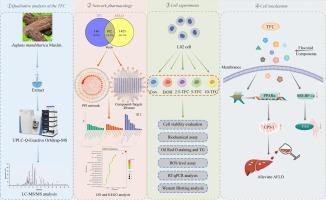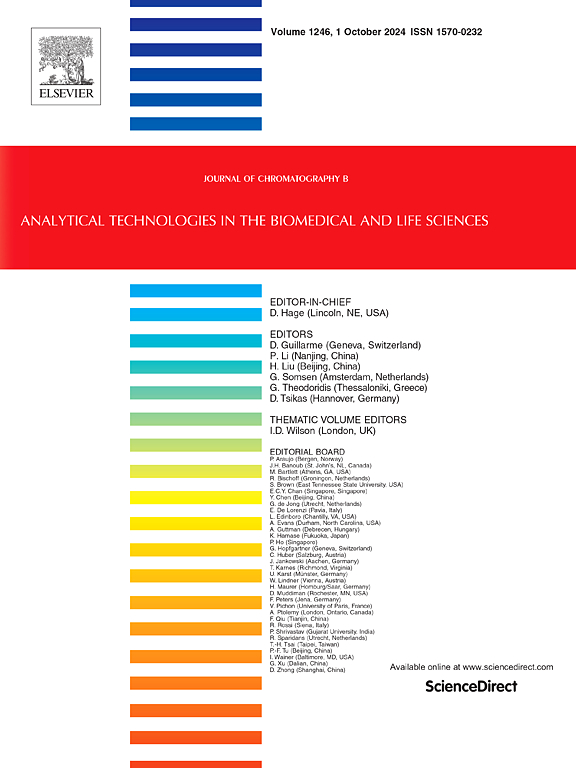Deciphering the impact and mechanism of total flavonoids from Cortex Juglandis Mandshuricae on alcoholic fatty liver employing LC-MS/MS, network pharmacology analysis and in vitro validation
IF 2.8
3区 医学
Q2 BIOCHEMICAL RESEARCH METHODS
引用次数: 0
Abstract
The Cortex Juglandis Mandshuricae (CJM) has the efficacy of penetrating the liver meridian, removing heat and dampness, and alleviating the liver, which corresponds to the pathogenesis of alcoholic fatty liver disease (AFLD) with damp heat accumulation. Modern research has shown that total flavonoids from Cortex Juglandis Mandshuricae (TFC) have hepatoprotective, antioxidant and antitumour pharmacological effects. However, there is no any investigation on the mechanism of TFC improving AFLD. In this work, a valid strategy combining UPLC-Q-Exactive Orbitrap-MS, network pharmacology and in vitro cellular experimental validation is proposed to predict the targets and pathways of TFC to ameliorate AFLD and to explore its mechanism of action. As a result, 26 flavonoids and 182 targets linked to TFC and AFLD were identified. These compounds realize their critical targets via various signaling pathways and perform multiple biological functions on the basis of the constructed compound-disease target networks. In vitro experiments demonstrated TFC had a protective impact on ethanol-treated L02 cells to a certain extent and could diminished lipid accretion. In addition, RT-qPCR and western blot results illustrated that TFC could regulate the expression of PPARα, CPT-1, SREBP-1c and FAS, and inhibit alcohol-induced lipid accumulation in L02 cells thereby alleviating AFLD. The present study further provides experimental justification for TFC to ameliorate AFLD in practical applications.

通过LC-MS/MS、网络药理学分析和体外验证,破译Cortex Juglandis Mandshuricae总黄酮对酒精性脂肪肝的影响和机制
黄精具有入肝经、清热利湿、疏肝理气的功效,与湿热蕴结型酒精性脂肪肝的发病机理相吻合。现代研究表明,毛果芸香科植物毛果芸香中的总黄酮具有保肝、抗氧化和抗肿瘤的药理作用。然而,目前尚未对 TFC 改善 AFLD 的机制进行任何研究。本研究提出了一种结合 UPLC-Q-Exactive Orbitrap-MS、网络药理学和体外细胞实验验证的有效策略,以预测 TFC 改善 AFLD 的靶点和途径,并探索其作用机制。结果发现了 26 种黄酮类化合物和 182 个与 TFC 和 AFLD 相关的靶点。在构建的化合物-疾病靶点网络基础上,这些化合物通过各种信号通路实现其关键靶点,并发挥多种生物学功能。体外实验表明,TFC对乙醇处理的L02细胞有一定程度的保护作用,并能减少脂质增生。此外,RT-qPCR和Western blot结果表明,TFC能调节PPARα、CPT-1、SREBP-1c和FAS的表达,抑制酒精诱导的L02细胞脂质蓄积,从而缓解AFLD。本研究进一步为 TFC 在实际应用中改善 AFLD 提供了实验依据。
本文章由计算机程序翻译,如有差异,请以英文原文为准。
求助全文
约1分钟内获得全文
求助全文
来源期刊

Journal of Chromatography B
医学-分析化学
CiteScore
5.60
自引率
3.30%
发文量
306
审稿时长
44 days
期刊介绍:
The Journal of Chromatography B publishes papers on developments in separation science relevant to biology and biomedical research including both fundamental advances and applications. Analytical techniques which may be considered include the various facets of chromatography, electrophoresis and related methods, affinity and immunoaffinity-based methodologies, hyphenated and other multi-dimensional techniques, and microanalytical approaches. The journal also considers articles reporting developments in sample preparation, detection techniques including mass spectrometry, and data handling and analysis.
Developments related to preparative separations for the isolation and purification of components of biological systems may be published, including chromatographic and electrophoretic methods, affinity separations, field flow fractionation and other preparative approaches.
Applications to the analysis of biological systems and samples will be considered when the analytical science contains a significant element of novelty, e.g. a new approach to the separation of a compound, novel combination of analytical techniques, or significantly improved analytical performance.
文献相关原料
| 公司名称 | 产品信息 | 采购帮参考价格 |
|---|---|---|
| 上海源叶 |
Hyperin
|
|
| 上海源叶 |
Guaijaverin
|
|
| 上海源叶 |
Afzelin
|
|
| 上海源叶 |
Luteolin
|
 求助内容:
求助内容: 应助结果提醒方式:
应助结果提醒方式:


